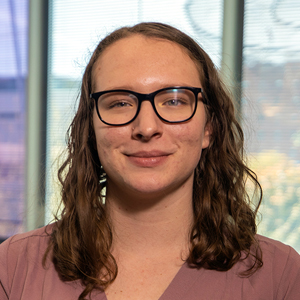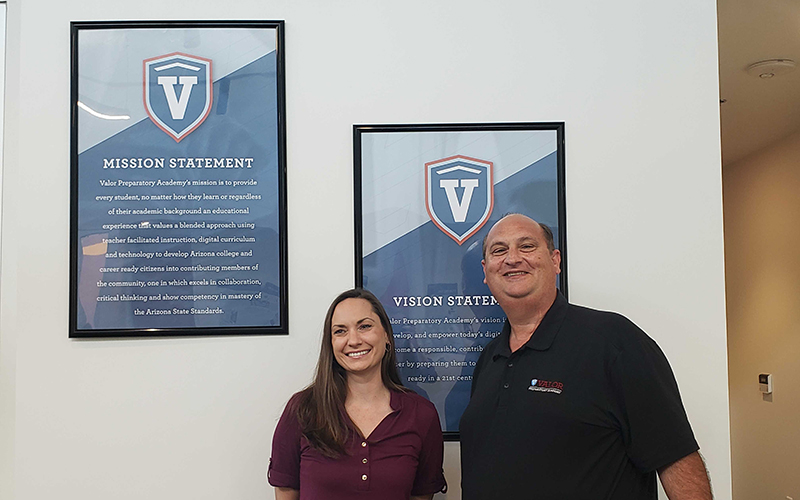PHOENIX – With the development of new technology over the past few decades, teachers now can do something they’ve never done before: bring onscreen lectures to their students’ homes. Arizona classrooms have begun using this teaching method to flip traditional homework and in-class lectures.
Flipped classrooms swap what students do in class with what they usually do at home. Homework becomes watching a teacher’s video lectures, sometimes in tandem with a reading assignment or exercise, at home, then coming to class the next day to work on projects. Through those projects, students are able to apply in class what they learned from the video, with their teacher ready to assist and answer questions.
Advocates of flipped classrooms say the concept allows teachers to create a more collaborative environment, provides students more class time to get help, adapts to students’ different learning styles and bolsters students at home through class time working with assignments.
Still, the method has some drawbacks as teachers shift their curriculums and create new learning materials. And flipped classrooms may widen the achievement gap for students who face income disparities or other challenges.
Flipped learning in Arizona
One school in Goodyear flipped all its classes and is working towards improving their model for the next school year based on student needs and performance.
“These kids are not just getting the information presented to them and then going home and filling out worksheets and papers and trying to do a project at home on their own,” said Leonard Edlund, principal of Valor Preparatory Academy of Arizona. “They’re getting the information presented to them at home, then they’re coming here and actually learning how to apply it.”
“We’ve seen that from students who have come from other schools that have told us, ‘I don’t just have to memorize a math formula here. I have to actually know how I use that math formula and what it does for me.’ I mean, that’s a huge step forward for these kids.”
The Goodyear school – which opened in the fall – had 24 students in the 2019-20 school year in grades 7 through 9. The school day lasts from 8 a.m. to noon and students are able to stay until 3 p.m. to get help from teachers and meet in clubs.
Right now, most of their curriculum is through an online program that students use to prepare for class that is paired with in-class activities, Edlund said.
Valor educators said hands-on activities help students connect what they learn to their own experiences and to the rest of the world.
“They’d much rather come in and build something, like a catapult, than come in and listen to someone talk about Newton’s laws,” science instructor Andrea Murphy said.
“We typically say it’s their job to go to school and to learn. Well, what do they want to do? They want to hang out with their friends. How do we combine that to make them want to learn? They get to do projects and collaborate with their peers and they get to learn from each other as well.”
A typical day in Murphy’s class starts with a review of the previous night’s material, an activity that may be a project or a rotation among several class stations, followed by a brief discussion about the topics for that night’s material.
Murphy described one student who has grown academically, socially and emotionally because of flipped learning. She’s able, for example, to participate in large group discussions through an online discussion board.
“She’s got some processing delays, so she’s able to stop her video and rewind it, or reperform the tutorials as many times as she needs to really get those concepts without the peer pressure around her.”
The challenges of a flipped classroom
The flipped classroom also brings challenges – it takes time to develop different lesson plans, some teachers create inadequate and boring videos, and students have to make sure they’re prepared for projects when they arrive in class.
Jon Bergmann, considered one of the pioneers of flipped learning, said teachers’ mistakes include lecture videos that are too long and not teaching their students how to watch the videos. He takes the first two weeks of the school year to teach his students how to properly take notes in class before sending them home with the videos.
Access to technology is another issue that concerns teachers, students and families. According to the Federal Communications Commission, 6% of Americans lack access to reliable internet.
Bergmann, who has been developing the flipped classroom model since 2007 and has several books published about it with fellow teacher Aaron Sams, said flipped learning is possible even in areas that lack internet access. For example, teachers and students in Misiones Province in Argentina are overcoming unreliable internet, he said.
When he went to Misiones Province about three years ago to help flip the schools there, Bergmann saw that most students had cellphones and recommended that the schools use them.
“The kids were getting the content through Bluetooth and stuff like that when they were at school so they could take it home on their device,” Bergmann said. “Now, they didn’t have reliable internet in rural Argentina, but they were making it work.”
Schools can also use other tactics to create a flipped learning environment that engages students more than traditional classrooms. One example Bergmann has seen in younger grades is a station rotation, where students move to different stations in the classroom, often with one station being an online resource.
Widening the equity gap
The flipped classroom also may widen the achievement gap for low-income students and certain racial and ethnic communities who don’t have access to technology.
In 2019, the School Effectiveness and Inequality Initiative, a research lab at the Massachusetts Institute of Technology’s department of economics, released a study that concluded students showed only short term learning gains in flipped classrooms and that the achievement gap between students was larger than traditional classrooms.
The study was conducted in the U.S. Military Academy at West Point in two classes – introduction to calculus and principles of economics. Each professor taught a regular course and a flipped course, and 1,328 students participated overall.
Students in the math course had short term learning gains while students in the economics course had no changes in learning, the study found.
“The flipped classroom has a 69 percent larger racial achievement gap and a 23 percent larger baseline academic ability achievement gap than the standard lecture and these differences persist through the final exam,” the study said. “Combined, these findings suggest educators should exercise caution when implementing the flipped classroom.”
Growth of flipped learning
Under flipped learning, students use traditional homework time to watch lectures and class time to apply the concepts under their teacher’s guidance. (Video by Velvet Wahl/Cronkite News)
The concept of flipped learning has been around for at least two decades, when Glenn Platt, a professor at Miami University in Ohio, and two other professors explored the idea of what they called an “inverted classroom.”
Such a classroom, according to a 2000 study they published, appealed to different styles of learning through group work in class and supplementary material outside of class. The setup “allows students to learn economics in a way that best matches their preferred learning style,” the study says.
The study notes learning styles based on preferred methods of learning, personality and processing information. Dependent learners rely on the teacher, collaborative learners work best in a team and independent learners learn best when they are left alone with the material, according to the study.
Some students prefer readings or lectures that allow them to observe and reflect, while others need to experiment with the material. By watching video lectures and doing in-class projects, students are able to learn the material in the way that best suits their style, Platt and his colleagues wrote.
Flipped learning and inverted classrooms lead to “active learning,” which engages students with a class’s material through deep thinking and applied knowledge through activities, according to the Center for Research on Learning and Technology at the University of Michigan.
Flipping a classroom, in K-12 and at college
Flipping a classroom depends on the student demographic and needs, said Greg Green, superintendent of the world’s first flipped school – Clintondale High School in eastern Michigan. He recommends schools start small when it comes to flipping, with only a few teachers doing it at first and figuring out what works best for students.
“We have to have the proper resources, the proper setting in order to have student growth occur. Focus really about creating a sustainable ecosystem for growth in your classroom,” he said. “It’s not a tech plan – we don’t want to build our plans based on things that are always changing. You want to have solid practice and implement the tools that align to that practice.”
Since flipping in 2010, Clintondale, which is in Clinton Township, north of Detroit, has had high student achievement and low failure rates, Green said.
Because Clintondale is in a lower income area, Green attributes that student success to setting aside class time for homework, which allows students who might not have support at home the time to ask for help.
“It was probably best practice for us to take control and provide all those resources and expertise while they’re covering the material, which is the most important part. It became a success,” Green said. “We increased our graduation rate, increased our kids going to school, college, decreased our failure rates dramatically and just changed the whole culture and vibe of our school.”
Flipped classrooms also have been implemented at the college level.
Jane Legacy, a clinical professor at Arizona State University, uses a version of flipped learning for her technology and computer literacy classes. Legacy developed a model she calls a “labryd” that combines flipped learning with a more personalized learning environment.
Legacy meets with her students individually about four times a semester to get to know them and help them build websites based on their majors. She likes being able to get to know her students more personally in those meetings and discover their needs and skills.
“A former student was actually the one that initially said this (labryd) sounds like a good idea. I picked it up and kind of ran with it,” she said.
Legacy also wanted to help students develop workplace skills, such as critical thinking, communication and leadership. She has seen students develop self-advocacy and those workplace skills throughout the semester.
“It’s all about building that confidence level,” Legacy said. “That you can do it, and that it’s okay to fail and have a safe environment to fail, knowing that there’s somebody behind you that’s pushing you to succeed.”
Students also seem to like the labryd model, and Legacy said she has fewer students fail the class.
“The grades improved, the surveys at the end of class improved because they saw that they weren’t just a number,” she said. “They weren’t just somebody coming in and sitting behind this computer.”
Focused on the flipped classroom in fall 2020
At Valor Prep Academy in Goodyear, Edlund said students seem to enjoy the class setup more than a traditional classroom.
The flipped model hasn’t been perfected in its first year of operation but school leaders are working to improve it for the fall.
“Success is about being better than you were yesterday. That’s kind of the way I feel about our program,” Edlund said. “If we’re better today than we were yesterday, that’s been a successful day. Tomorrow, we hope to be better.”

